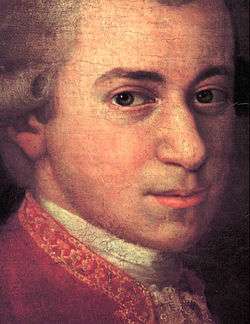Vesperae solennes de confessore (Mozart)
Vesperae solennes de confessore, K. 339, is a sacred work composed in 1780 by Wolfgang Amadeus Mozart. It is scored for SATB soloists, SATB choir, violin I, violin II, 2 trumpets, 3 trombones colla parte, 2 timpani, and basso continuo (violoncello, double bass, and organ, with optional bassoon obbligato).
It was composed for liturgical use in the Salzburg Cathedral.[1] The title "de confessore" was not Mozart's own, and was added by a later hand to his manuscript. It suggests that the work was intended for vespers held on a specific day on the liturgical calendar of saints ("confessors"); however, the saint in question has not been conclusively established.[2] This was Mozart's final choral work composed for the cathedral.[3]
Structurally, it is very similar to Vesperae solennes de Dominica (K. 321), composed in 1779. The setting is divided into 6 movements; as in Dominica, a setting of the Minor Doxology (Gloria Patri) concludes all movements, each recapitulating the opening themes. The first three psalms are scored in a bold, exuberant manner, contrasting with the strict, stile antico counterpoint of the a cappella fourth psalm,[3] and the tranquility of the fifth movement. The Magnificat sees a return to the style of the opening settings.
 |
|
| Problems playing this file? See media help. | |
- Dixit Allegro vivace, C major, 3/4
- Confitebor Allegro, E-flat major, common time
- Beatus vir Allegro vivace, G major, 3/4
- Laudate pueri Allegro, D minor, cut common time
- Laudate Dominum Andante, F major, 6/8
- Mozart departs from the structure of K. 321 in this movement. The earlier setting of Laudate Dominum is a highly melismatic soprano solo, with no choral interlude. In K. 339, the soprano solo is much simpler; the choir quietly enters at the conclusion of the psalm with the Gloria Patri, and the soloist rejoins them at the Amen.
- This movement is well-known outside the context of the larger work, and is often performed in isolation.[4]
- Magnificat Andante, C major, common time
- —"Et exultavit..." Allegro, C major, common time
References
- ↑ "About: Vesperae solemnes de confessore (Vespers), for soloists, chorus, and orchestra, K.339". Retrieved 20 February 2013.
- ↑ J. Frank Henderson (2006). "Mozart's Vesperae Solennes de Confessore: Identification of the Saint and Date" (PDF). Retrieved 20 February 2013.
- 1 2 Mark Aaron Humphrey (2006). The Stylistic and Historical Significance of Mozart's Mass in C Major K. 337. Retrieved 23 February 2013.
- ↑ Michael Steinberg (2005). Choral Masterworks: A Listener's Guide. p. 211. Retrieved 21 February 2013.
External links
- Vesperae solennes de confessore KV 339: Score and critical report (German) in the Neue Mozart-Ausgabe
- Free scores of Vesperae solennes de confessore in the Choral Public Domain Library (ChoralWiki)
- Vesperae solennes de confessore: Scores at the International Music Score Library Project
